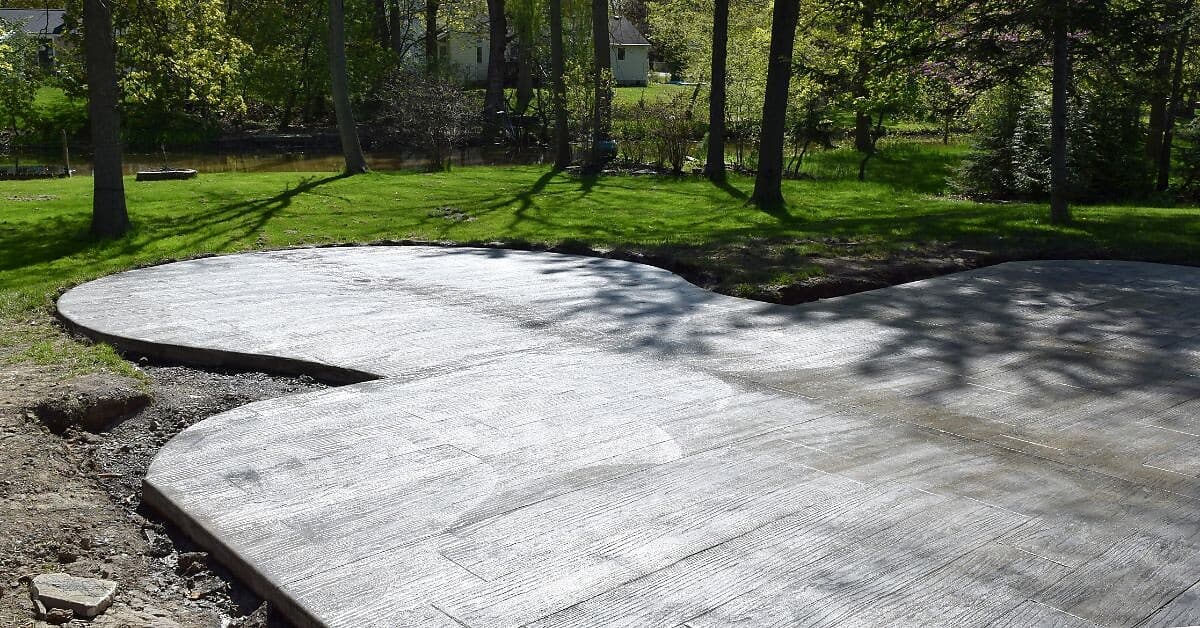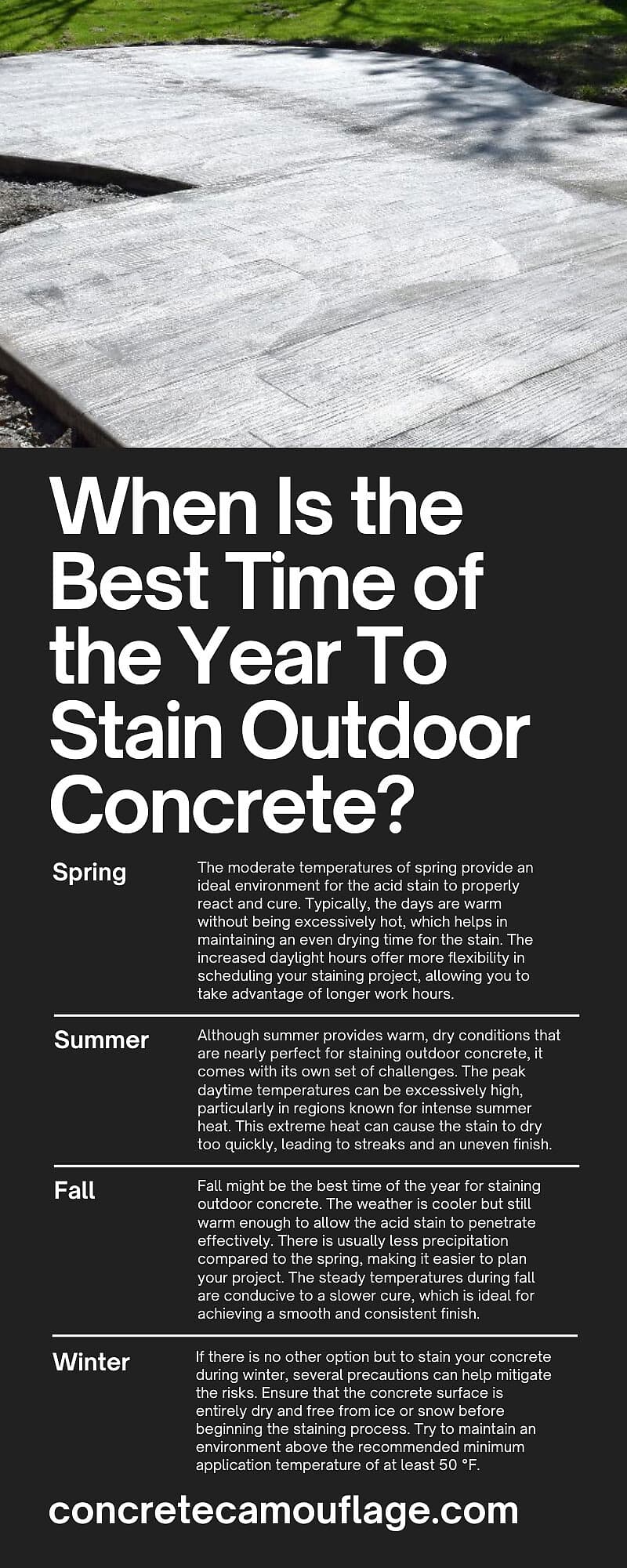When Is the Best Time of the Year To Stain Outdoor Concrete?

When Is the Best Time of the Year To Stain Outdoor Concrete?
Staining outdoor concrete is a highly effective way to enhance the aesthetic appeal and durability of your living spaces. Whether you're looking to renovate your patio, driveway, or walkways, choosing the right time to undertake this task can significantly impact the results.
Various factors play a crucial role in determining the optimal period for starting the process. Knowing exactly when to start the process involves more than just looking at a calendar; it requires a clear understanding of your local ecosystem and seasonal shifts.
This guide will tell you about the best time of the year to stain outdoor concrete to ensure that your efforts result in a beautiful, lasting finish. With the right preparation, staining your outdoor concrete can transform your space into a more inviting, attractive area while also extending the life span of your concrete surfaces.
Importance of Weather Conditions
Consistent and mild weather conditions are crucial for the optimal application and curing of concrete stains and sealers. When the weather is too wet or rainy, the high humidity and excess moisture can interfere with the stain's ability to lay the concrete surface uniformly. This can lead to blotchy and uneven color distribution, requiring additional work to correct.
Additionally, higher humidity can cause sealers to dry cloudy. It's important for the concrete to dry completely between each step of the process, so doing your work during drier days are paramount. Planning your staining project during a period of stable, moderate weather will facilitate a smoother application process and help you achieve a consistent, professional finish.
Spring
The moderate temperatures of spring provide an ideal environment for the acid stain to properly react and cure. Typically, the days are warm without being excessively hot, which helps in maintaining an even drying time for the stain. The increased daylight hours offer more flexibility in scheduling your staining project, allowing you to take advantage of longer work hours.
In addition to its moderate climate, spring's relatively low humidity levels prevent moisture from compromising the stain's reaction with the concrete surface. While occasional spring showers are common, you can manage these with careful planning.
Summer
Although summer provides warm, dry conditions that are nearly perfect for staining outdoor concrete, it comes with its own set of challenges. The peak daytime temperatures can be excessively high, particularly in regions known for intense summer heat. This extreme heat can cause the stain to dry too quickly, leading to streaks and an uneven finish.
To navigate these challenges, it is crucial to time your staining project carefully. Early morning is the best time for application, since temperatures are cooler and the sun is less intense. Concrete is a heat sink, trapping heat throughout the day and slowly releasing that heat through the night. Evenings are not particularly good times of day to work on your project because, even though the air may feel a bit cooler, the concrete is still holding its heat. So doing your work in the early mornings during hot summer months is best.
This timing can help you achieve a more even and consistent finish. Taking advantage of shaded areas or using temporary shade structures can provide a more controlled environment for the staining process.
Fall
Fall might be the best time of the year for staining outdoor concrete. The weather is cooler but still warm enough to allow the acid stain to penetrate effectively. There is usually less precipitation compared to the spring, making it easier to plan your project. The steady temperatures during fall are conducive to a slower cure, which is ideal for achieving a smooth and consistent finish.
Another significant advantage of staining in the fall is the lower humidity levels, which prevent moisture from compromising the stain's drying times. The drier air ensures that the stain can provide a richer and more enduring color.
Winter
If there is no other option but to stain your concrete during winter, several precautions can help mitigate the risks. Ensure that the concrete surface is entirely dry and free from ice or snow before beginning the staining process. Try to maintain an environment above the recommended minimum application temperature of at least 50 °F.
Monitoring weather forecasts closely is crucial during winter staining projects. Pick days with the most favorable conditions, ideally, dry and with no significant temperature fluctuations.
Humidity Levels Matter
Humidity plays a crucial role in determining the success of your concrete staining project. High humidity levels, typically above 70 percent, can significantly slow down the drying process of the stain, causing delays and increasing the likelihood of uneven absorption. This prolonged drying time can also heighten the risk of contaminants settling on the wet surface, leading to imperfections in the finish.
Extremely low humidity levels, such as those below 40 percent, can cause the stain to dry too quickly. This rapid drying often results in a patchy and inconsistent appearance, as the stain does not have sufficient time to penetrate deeply into the concrete. To achieve the best results, aim for a humidity level between 40-70 percent.
Surface Preparation and Timing
Proper surface preparation is key to successful concrete staining. Ensure the concrete is clean, dry, and free of any contaminants. Begin with a thorough cleaning using a power washer to remove dirt, grime, and any existing coatings. For stubborn stains or residues, a concrete cleaner or degreaser may be necessary.
Once clean, allow the concrete to dry completely, as moisture trapped in the pores can interfere with the stain's absorption process. Inspect the concrete for any cracks, chips, or surface imperfections. Repair any damage with concrete patching compound and allow it to cure. Plan your preparation and staining activities in such a way that you can complete the entire process within the ideal weather conditions.
Checking Local Weather Patterns
Historical weather data can be a valuable resource when planning your staining project, as it offers insights into seasonal trends and helps you identify periods with the most stable weather. Start by reviewing weather data for the past few years to identify months with consistent temperatures, low precipitation, and moderate humidity.
Online resources, such as weather websites and apps, provide up-to-date forecasts and historical data. Utilize these tools to monitor short-term and long-term forecasts, giving you a clearer picture of upcoming weather conditions.
Staining outdoor concrete can transform the look of your outdoor spaces, adding a unique look and durability. By understanding the best time of the year to undertake this project, you can ensure a professional-quality finish that lasts longer.
The choice of quality materials, such as artist-grade acid stain concrete, can also make a noticeable difference in the final appearance and longevity of your project. These specialized stains provide richer, more vibrant colors. With the right preparation and timing, your outdoor concrete can form the stunning foundation of your home's aesthetic.
